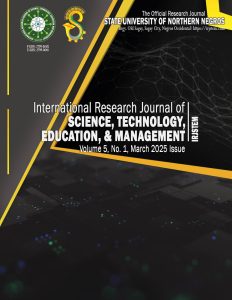March 2025

The use of engineering design process-oriented activities with GRASPS model integration in grade 11 Genetics
Jereme Ll. Astaño1, Ma. Lourdes M. Macasinag2
1Bicol University Graduate School, Philippines
2Bicol University College of Education, Philippines
Full Paper PDF Abstract 1-22
Community-Driven GIS – Based landslide hazard mapping for Kias, Baguio City, Philippines
Florence Leslie Campolet1, Blanche Rosaida Mallare2, Yuriko Lynn Suba3, Joana Marie Obfan4, Jeorge Antonio5
1-5Saint Louis University, Bonifacio St., Baguio City, Philippines
Full Paper PDF Abstract 23-43
Development of digital handouts based on critical thinking skills as teaching material for pre-service science teachers
Erviyenni, Fitri Aldresti, Sri Haryati
Universitas Riau, Indonesia
Full Paper PDF Abstract 44-56
Determinants of out-of-school youth dropout: Pathways to educational re-engagement
Khalid D. Daud
Faculty, Rufo de la Cruz Integrated School, Tubod, Lanao del Norte, Philippines
Graduate student, Mindanao State University, Marawi, Lanao del Sur, Philippines
Full Paper PDF Abstract 57-66
A case study on organizing a workspace using 5S Technique and LIFO Principle
Tshegofatso Lesiba Seema1, Kapil Gupta2
1Department of Mechanical and Industrial Engineering Technology, University of Johannesburg, Johannesburg-
2028, Republic of South Africa
2Department of Mechanical and Industrial Engineering Technology, University of Johannesburg, Johannesburg-
2028, Republic of South Africa
Full Paper PDF Abstract 67-81
Interplay of organizational change and trust on the organizational effectiveness in the College of Engineering of the Nueva Vizcaya State University Bambang Campus: Perspective of generation XYZ faculty members
Jeanelyn R. Tominez1, Jerry F. Tominez2, Salvador A. Loria Jr.2, Noel T. Florencondia2
1Department of Mechanical Engineering, Nueva Vizcaya State University, Bambang Nueva Vizcaya, Philippines
2College of Engineering, Nueva Ecija University of Science and Technology, Nueva Ecija, Philippines
Full Paper PDF Abstract 82-99
Moral and social development analysis of sixth-grade students: Insights from an Indonesian Islamic primary school
Indri Khairunnisa Erwinsyah1, Muhammad Ikhlas2, Selvi Simanjuntak3, Trisna Natalia Br Parapat4, Rendi Prilandi5, Asiah Ramadhani6
1,3,4,5Undergradute student of Primary School Teacher Education Program, Universitas Negeri Medan, Indonesia
2,6Lecturer at Primary School Teacher Education Program, Universitas Negeri Medan, Indonesia
Full Paper PDF Abstract 100-112
A narrative literature review of ‘Women Teach, Men Lead’ in Tanzanian schools
Joyce Nemes
The University of Dodoma, United Republic of Tanzania
Full Paper PDF Abstract 113-125
Peer tutoring day: Perceptions and its effectiveness on the academic performance of students in learning high school physics
Febeto Jr. L. Potutan1, Samuel Macagba III2
The University of Dodoma, United Republic of Tanzania
1Santiago National High School, DepEd Iligan City, Philippines
2Xavier University- Ateneo de Cagayan Junior High School, Philippines
Full Paper PDF Abstract 126-136
The integration of augmented reality tools in South African schools: Selected preservice teachers’ views
Olika Moila
Department of Mathematics, Science and Technology Education, Walter Sisulu University, Mthatha, Souths Africa
Full Paper PDF Abstract 137-149
